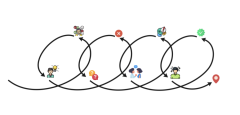Jonauskaite, D., Abu-Akel, A., Dael, N., Oberfeld, D., Abdel-Khalek, A.M., Al-Rasheed, A.S., Antonietti, J.-P., Bogushevskaya, V., Chamseddine, A., Chkonia, E., Corona, V., Fonseca-Pedrero, E., Griber, Y.A., Grimshaw, G., Hasan, A.A., Havelka, J., Hirnstein, M., Karlsson, B.S.A., Laurent, E. and Lindeman, M. (2020). Universal Patterns in Color-Emotion Associations Are Further Shaped by Linguistic and Geographic Proximity. Psychological Science, 31(10), pp.1245–1260.
Popova, M. (2012). Goethe on the Psychology of Color and Emotion. [online] The Marginalian. Available at: https://www.themarginalian.org/2012/08/17/goethe-theory-of-colours/ [Accessed 15 Aug. 2021].
International colour-emotion association survey: https://www.colourexperience.ch/ongoing-projects


Colour and Emotion – Goethe
YELLOW: In its highest purity it always carries with it the nature of brightness, and has a serene, gay, softly exciting character.
RED-YELLOW: The red-yellow gives an impression of warmth and gladness since it represents the hue of the intenser glow of the fire.
YELLOW-RED: In looking steadfastly at a perfectly yellow-red surface, the colour seems actually to penetrate the organ. It produces extreme excitement and still acts thus when somewhat darkened. A yellow-red cloth disturbs and enrages animals. I have known men of education to whom its effect was intolerable if they chanced to see a person dressed in a scarlet cloak on a grey, cloudy day.
BLUE: This colour has a peculiar and almost indescribable effect on the eye. As a hue it is powerful — but it is on the negative side, and in its highest purity is, as it were, a stimulating negation. Its appearance, then, is a kind of contradiction between excitement and repose.
RED-BLUE: Blue deepens very mildly into red, and thus acquires a somewhat active character, although it is on the passive side. Its exciting power is, however, of a different kind from that of the red-yellow. It may be said to disturb, rather than enliven.
BLUE-RED: This unquiet feeling increases as the hue progresses, and it may be safely assumed, that a carpet of a perfectly pure deep blue-red would be intolerable. On this account, when it is used for dress, ribbons, or other ornaments, it is employed in a very attenuated and light state, and thus displays its character as above defined, in a peculiarly attractive manner.
RED: The effect of this colour is as peculiar as its nature. It conveys an impression of gravity and dignity, and at the same time of grace and attractiveness.
GREEN: The eye experiences a distinctly grateful impression from this colour. If the two elementary colours are mixed in perfect equality so that neither predominates, the eye and the mind repose on the result of this junction as upon a simple colour. The beholder has neither the wish nor the power to imagine a state beyond it.
